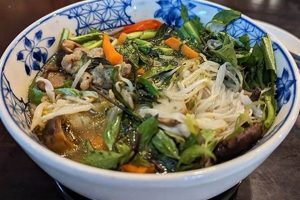Cuisine from the South American nation reimagined without any animal products constitutes a distinct culinary field. This involves adapting traditional recipes and utilizing plant-based alternatives to recreate classic dishes. For instance, a staple like causa, traditionally made with mashed yellow potatoes, aji amarillo (Peruvian yellow pepper), and often layered with tuna or chicken, can be transformed with fillings of avocado, black olives, and a plant-based mayonnaise.
The appeal of this culinary adaptation lies in several factors. Ethical considerations regarding animal welfare, environmental sustainability, and health benefits are primary drivers. Furthermore, it allows individuals adhering to plant-based diets to experience the rich and diverse flavors of a national gastronomy that heavily features meat and dairy. Historically, Peru’s indigenous population relied significantly on plant-based foods, providing a foundation for modern adaptations. Ingredients such as quinoa, potatoes, corn, and various beans offer ample opportunities for creative and satisfying meals.
The following sections will explore specific plant-based adaptations of familiar dishes, highlight key Peruvian ingredients suitable for these creations, and provide insights into finding establishments and resources that support the creation and consumption of such cuisine.
Practical Guidance for Plant-Based Peruvian Culinary Exploration
The following outlines practical guidance for successfully navigating and preparing Peruvian cuisine in alignment with plant-based dietary principles.
Tip 1: Master the Aji Amarillo Paste. This foundational ingredient, essential for countless traditional dishes, can be prepared at home from fresh aji amarillo peppers. Roasting the peppers prior to blending enhances flavor.
Tip 2: Embrace Quinoa in Place of Rice. Quinoa, a native Peruvian grain, provides a complete protein source and nutty flavor. Utilize it in dishes like arroz con pollo substituting the chicken with plant-based protein and vegetable medley.
Tip 3: Explore the Versatility of Potatoes. Peru boasts a vast variety of potato types. Experiment with different potatoes in causa or create hearty stews.
Tip 4: Utilize Mushrooms for Umami. Mushrooms are a good replacement for meat to add the savory taste in dishes like lomo saltado which uses mushroom rather than beef.
Tip 5: Recreate Leche de Tigre with Plant-Based Ingredients. The citrus-based marinade, typically used in ceviche, can be replicated using lime juice, ginger, garlic, and aji limo peppers, excluding the fish.
Tip 6: Adapt Traditional Sauces. Classic sauces like ocopa (made with aji amarillo, huacatay, and cheese) can be adapted using plant-based cheeses or cashew cream to maintain the creamy texture and flavor profile.
Tip 7: Seek Out Peruvian Ingredients. Online retailers and specialty stores often carry essential Peruvian ingredients like aji amarillo paste, huacatay (black mint), and lucuma powder, vital for authentic flavor profiles.
Successfully adapting Peruvian cuisine involves understanding foundational flavors and textures, and applying plant-based alternatives creatively. This approach allows for enjoyment of the cultural richness of the cuisine without compromising dietary principles.
The concluding section will summarize the key benefits and further explore resources for delving into this culinary domain.
1. Plant-based Ingredients
The successful adaptation of Peruvian cuisine to plant-based dietary standards hinges on the strategic employment of specific ingredients. These ingredients not only replace animal products but also strive to replicate or enhance the authentic flavors and textures of traditional dishes.
- Quinoa and Amaranth
These ancient grains, indigenous to the Andean region, offer complete protein sources and serve as versatile substitutes for rice or wheat in numerous dishes. Quinoa can be incorporated into stews, salads, and even used as a base for recreating dishes like arroz con pollo (rice with chicken), substituting the chicken with plant-based alternatives and vegetables.
- Andean Tubers: Potatoes, Oca, and Mashua
Peru boasts a vast diversity of native tubers, with potatoes being the most well-known. These tubers are fundamental to Peruvian cuisine and can be readily adapted in their plant-based iterations. They are essential in dishes such as causa (layered potato dish) and various stews, providing both substance and unique flavor profiles.
- Legumes: Beans, Lentils, and Tarwi (Lupin Bean)
Legumes play a critical role in providing protein and fiber. Various beans, lentils, and the lesser-known tarwi (lupin bean) can be incorporated into stews, soups, and fillings for dishes like papas rellenas (stuffed potatoes), replacing traditional meat-based fillings. The nutritional value and versatility of legumes make them indispensable.
- Aji Peppers and Andean Herbs
The distinctive flavors of Peruvian cuisine rely heavily on aji peppers (such as aji amarillo, aji panca, and aji limo) and herbs like huacatay (black mint) and paico. These ingredients are inherently plant-based and are crucial for achieving authentic flavor profiles in adapted dishes. They are indispensable in recreating sauces, marinades, and stews.
The careful selection and utilization of plant-based ingredients, mirroring or enhancing the textures and flavors of their animal-derived counterparts, are paramount for the successful execution of this particular culinary adaptation. Incorporating indigenous Andean grains, diverse tubers, protein-rich legumes, and flavorful peppers and herbs is essential for creating dishes that are both authentically Peruvian and fully compliant with plant-based dietary standards.
2. Flavor Adaptation
The process of flavor adaptation is paramount to the successful execution of Peruvian cuisine within plant-based dietary parameters. The authentic taste profiles of Peruvian dishes are often built upon animal products, necessitating the strategic manipulation and substitution of ingredients to replicate or simulate those flavors using only plant-based sources. The effectiveness of this adaptation directly influences the acceptability and perceived authenticity of the resultant culinary creations.
Several strategies are employed to achieve desirable flavor adaptation. The utilization of umami-rich ingredients, such as mushrooms or seaweed, serves to mimic the savory depth often derived from meat-based stocks or braised meats. The incorporation of smoked paprika or liquid smoke can impart a similar smoky quality found in traditionally wood-fired Peruvian cooking. Furthermore, the application of specific cooking techniques, like caramelizing onions or roasting vegetables, enhances the Maillard reaction, producing complex flavors that contribute to the overall taste experience. For instance, adapting lomo saltado requires replacing the beef with portobello mushrooms, marinated to emulate the texture and savory character of the original dish. The marinade, often incorporating soy sauce (or a tamari alternative), smoked paprika, and garlic, contributes to the desired umami and smoky notes.
Successful flavor adaptation in this culinary context requires a thorough understanding of the underlying flavor compounds present in traditional Peruvian ingredients and dishes. It also demands a willingness to experiment with alternative plant-based components and cooking methodologies to effectively replicate the desired taste profiles. The degree to which this flavor adaptation succeeds determines the extent to which the plant-based rendition captures the essence of Peruvian gastronomy.
3. Cultural Authenticity
The maintenance of cultural authenticity represents a central challenge in adapting Peruvian cuisine to plant-based dietary guidelines. Preservation of recognizable flavors, textures, and presentation styles is crucial for upholding the cultural integrity of traditional dishes, even when animal products are entirely excluded.
- Ingredient Sourcing and Substitution
Authenticity is contingent upon the utilization of traditional Peruvian ingredients whenever possible. When direct substitution is necessary, the replacement ingredient should possess analogous flavor profiles and textural properties. For instance, employing Andean potatoes native to Peru contributes to authenticity more effectively than relying solely on common potato varieties. Similarly, using aji amarillo paste, even in plant-based adaptations, is crucial to retain the signature Peruvian heat and flavor.
- Preservation of Traditional Cooking Techniques
Certain cooking methods are intrinsically linked to Peruvian culinary heritage. Techniques such as stir-frying at high heat (as in lomo saltado), or slow simmering in earthenware pots, contribute significantly to the overall character of the dishes. Adhering to these techniques, even when utilizing plant-based ingredients, assists in maintaining cultural authenticity.
- Representation of Traditional Dishes
Faithfully recreating recognizable Peruvian dishes, rather than inventing entirely new plant-based creations, plays a vital role. Adapting classics like causa or aji de gallina (traditionally made with chicken) demonstrates a commitment to cultural preservation. The visual presentation, including plating and garnishing, should also mirror traditional styles.
- Understanding Regional Variations
Peruvian cuisine is diverse, with distinct regional variations in ingredients and preparation methods. Recognizing and respecting these regional differences in plant-based adaptations demonstrates a deeper understanding of the culinary landscape and contributes to greater cultural authenticity. For example, a plant-based ceviche adaptation should reflect the regional variations in aji pepper usage and accompanying vegetables.
Achieving cultural authenticity in plant-based Peruvian cuisine requires a nuanced approach that balances dietary restrictions with culinary tradition. The successful integration of traditional ingredients, cooking methods, dish representations, and regional awareness contributes significantly to maintaining the cultural integrity of the cuisine.
4. Nutritional Profile
The nutritional profile of Peruvian cuisine reimagined with plant-based ingredients warrants detailed examination. Adapting traditional recipes to exclude animal products significantly alters the macronutrient and micronutrient composition. A comparative analysis is essential to ascertain the health benefits and potential shortcomings of this dietary shift.
- Protein Sources and Adequacy
Traditional Peruvian cuisine often relies on meat, poultry, and fish as primary protein sources. Plant-based adaptations must incorporate alternative sources like quinoa, beans, lentils, and nuts to meet protein requirements. The completeness of these protein sources, considering amino acid profiles, is crucial. For example, combining quinoa with beans provides a more complete amino acid profile compared to relying solely on either ingredient. Ensuring adequate protein intake is paramount for maintaining muscle mass and supporting various bodily functions.
- Fiber Content and Digestive Health
Plant-based diets are typically higher in dietary fiber compared to diets rich in animal products. This increased fiber content can promote digestive health, regulate blood sugar levels, and contribute to satiety. Vegan Peruvian dishes, incorporating ingredients like Andean tubers, vegetables, and legumes, are inherently rich in fiber. This can be particularly beneficial for individuals seeking to improve their digestive health or manage weight.
- Vitamin and Mineral Considerations
Certain micronutrients, such as vitamin B12, iron, and calcium, are often associated with animal-derived foods. Plant-based Peruvian diets require careful planning to ensure adequate intake of these nutrients. Fortified plant-based milks, supplements, and iron-rich plant foods like spinach and lentils can help address these potential deficiencies. Monitoring micronutrient levels through regular blood tests is advisable for individuals adhering to a strictly plant-based diet.
- Fat Content and Lipid Profile
Traditional Peruvian dishes may contain significant amounts of saturated fat from animal products. Plant-based adaptations often utilize healthier sources of fat, such as avocados, nuts, seeds, and olive oil. These fats are rich in monounsaturated and polyunsaturated fatty acids, which can contribute to improved cardiovascular health. However, portion control remains important, as excessive consumption of any fat source can lead to weight gain.
The transformation of Peruvian cuisine through plant-based adaptation offers both nutritional advantages and potential challenges. While fiber content and healthy fat intake generally improve, careful attention must be paid to protein adequacy and micronutrient sufficiency. Thoughtful meal planning, strategic ingredient selection, and, in some cases, supplementation are essential to optimize the nutritional profile and ensure overall health and well-being.
5. Sustainability Factors
The intersection of sustainability and plant-based Peruvian cuisine reveals a complex interplay of environmental and ethical considerations. The reduced environmental footprint associated with plant-based diets directly influences the sustainability of culinary practices. Specifically, the decreased demand for land and resources needed to raise livestock translates to reduced deforestation, greenhouse gas emissions, and water consumption. Replacing beef in a dish like lomo saltado with mushrooms, for example, drastically diminishes the carbon footprint of that single dish. This shift reflects a conscious effort to mitigate the environmental impact of food production.
Furthermore, the sourcing of ingredients plays a crucial role in the sustainability equation. Prioritizing locally grown and sustainably harvested crops minimizes transportation costs and supports regional economies. Using indigenous Andean grains, such as quinoa and amaranth, promotes biodiversity and reduces reliance on monoculture farming practices, which can deplete soil nutrients and increase vulnerability to pests and diseases. The utilization of sustainably harvested palm hearts as a seafood alternative in plant-based ceviche showcases a commitment to responsible resource management.
In conclusion, the adoption of plant-based Peruvian cuisine offers a pathway towards more sustainable food systems. By reducing reliance on resource-intensive animal agriculture, promoting local sourcing, and embracing biodiversity, this culinary adaptation aligns with broader environmental goals. However, the long-term sustainability of this approach hinges on continued efforts to improve agricultural practices, reduce food waste, and educate consumers about the environmental consequences of their dietary choices.
6. Recipe Innovation
Recipe innovation forms a cornerstone of successful plant-based adaptations of Peruvian cuisine. As traditional Peruvian gastronomy relies heavily on animal products, creativity and experimentation are essential to recreate familiar flavors and textures without compromising dietary principles. The demand for novel recipes arises directly from the need to reconcile cultural culinary heritage with contemporary ethical and dietary concerns. The development of plant-based causa variations, employing avocado and plant-based mayonnaise instead of traditional tuna or chicken fillings, exemplifies this innovative spirit. Without such recipe innovation, the accessibility and appeal of plant-based Peruvian food would be significantly limited.
Furthermore, recipe innovation facilitates the incorporation of underutilized plant-based ingredients into the Peruvian culinary lexicon. Andean grains like quinoa and amaranth, while historically significant, gain renewed prominence as versatile substitutes for meat and dairy. The adaptation of aji de gallina, traditionally a chicken stew, using mushrooms and cashew cream sauce instead, illustrates the potential for inventive ingredient combinations. Culinary experimentation allows chefs and home cooks to explore previously uncharted territories, expanding the range of available plant-based Peruvian dishes.
In conclusion, recipe innovation is not merely a stylistic choice but a fundamental requirement for the growth and acceptance of plant-based Peruvian cuisine. It bridges the gap between tradition and modernity, enabling individuals to enjoy the rich flavors of Peru while adhering to ethical and health-conscious dietary choices. While challenges remain in replicating complex flavors and textures, the continued pursuit of recipe innovation promises to unlock new culinary possibilities and solidify the place of plant-based Peruvian cuisine on the global stage.
Frequently Asked Questions About Vegan Peruvian Food
The following addresses common inquiries regarding the nature, preparation, and nutritional aspects of Peruvian cuisine adapted for plant-based diets.
Question 1: What defines “vegan Peruvian food”?
The term denotes traditional Peruvian dishes reinterpreted and prepared exclusively with plant-based ingredients, excluding all animal products and derivatives. This encompasses adapting recipes to replace meat, poultry, fish, dairy, and eggs with plant-based alternatives.
Question 2: Is it possible to replicate the authentic flavors of Peruvian dishes without using animal products?
While direct replication may be challenging, skilled culinary adaptation can approximate authentic flavors through strategic ingredient substitutions and the use of traditional Peruvian seasonings. Techniques such as employing umami-rich vegetables and utilizing aji peppers are crucial.
Question 3: What are the primary plant-based protein sources utilized in place of meat in Peruvian cuisine?
Quinoa, various beans, lentils, nuts, and seeds are commonly employed as protein sources. These ingredients are incorporated into stews, fillings, and other dishes to ensure adequate protein intake.
Question 4: Are there any specific nutritional concerns associated with adopting a vegan Peruvian diet?
Potential concerns include ensuring adequate intake of vitamin B12, iron, calcium, and omega-3 fatty acids. Supplementation or strategic consumption of fortified foods may be necessary to address these concerns.
Question 5: Can traditional Peruvian dishes, such as aji de gallina or lomo saltado, be successfully adapted to plant-based versions?
Yes, with recipe innovation and the use of plant-based alternatives, these dishes can be adapted. For example, mushrooms can replace beef in lomo saltado, and cashew cream can substitute for dairy in aji de gallina.
Question 6: How does a plant-based Peruvian diet contribute to environmental sustainability?
By reducing reliance on animal agriculture, plant-based diets generally require less land, water, and energy, thereby minimizing greenhouse gas emissions and deforestation. Sourcing local and sustainable ingredients further enhances the environmental benefits.
This examination of frequently raised questions provides a foundation for understanding the scope and nuances of Peruvian cuisine adapted for plant-based diets. Further exploration into specific recipes and culinary techniques is encouraged.
The subsequent discussion will focus on resources available for learning more about vegan Peruvian food.
Conclusion
The preceding discussion has comprehensively explored the multifaceted nature of vegan peruvian food. It has illuminated the challenges and opportunities associated with adapting a traditionally meat-centric cuisine to plant-based dietary principles. Core elements encompassing plant-based ingredients, flavor adaptation, cultural authenticity, nutritional profiles, sustainability factors, and recipe innovation have been examined in detail, providing a holistic understanding of this evolving culinary landscape.
The future trajectory of vegan peruvian food lies in continued culinary experimentation, increased accessibility of specialized ingredients, and growing consumer awareness. A dedication to preserving cultural heritage while embracing sustainable and ethical food practices will define its ongoing development. Continued investigation and exploration of this culinary field are encouraged.







